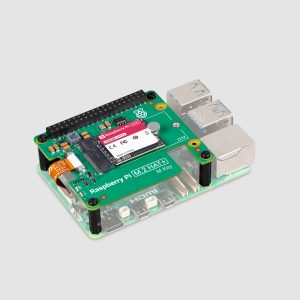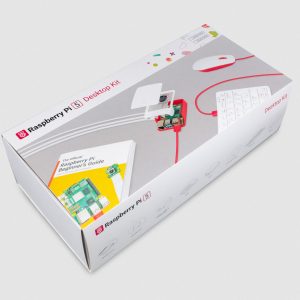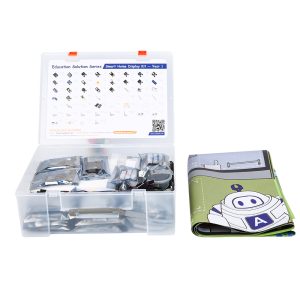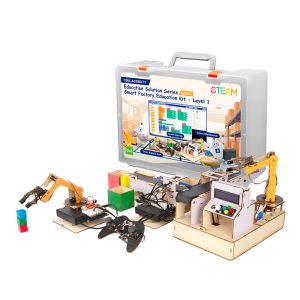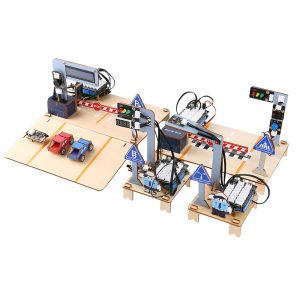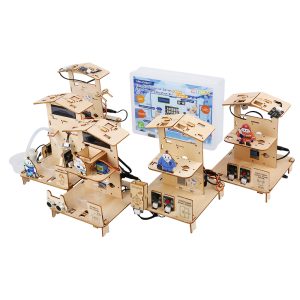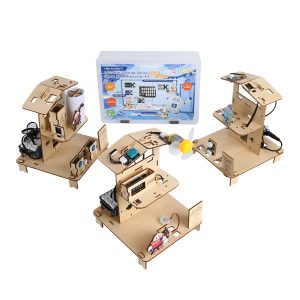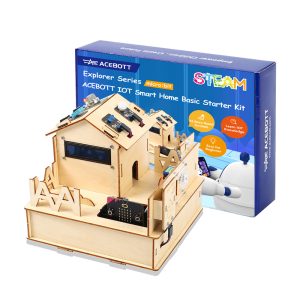No products in the cart.
Enjoy Our Daily Deals
20%
Hurry up offer ends in:
28800Embedded Computers, Education & Maker Boards, Other Educational & Maker Boards, Raspberry Pi
Raspberry Pi Camera V2 NOIR

Embedded Computers, Education & Maker Boards, Other Educational & Maker Boards, Raspberry Pi
Raspberry Pi Camera V2 NOIR
0 out of 5
(0)The camera works with?all models?of Raspberry Pi 1, 2, 3 and 4. It can be accessed through the MMAL and V4L APIs, and there are numerous third-party libraries built for it, including the?Picamera?Python library. See the?Getting Started with Picamera?resource to learn how to use it.
SKU: SWB04001
₦30,000 ₦36,400
Displays, Raspberry Pi
Raspberry Pi 7″ touchscreen display
0 out of 5
(0)Specification
Raspberry Pi OS provides touchscreen drivers with support for ten-finger touch and an on-screen keyboard, giving you full functionality without the need to connect a keyboard or mouse.
The 800 x 480 display connects to Raspberry Pi via an adapter board that handles power and signal conversion. Only two connections to your Raspberry Pi are required: power from the GPIO port, and a ribbon cable that connects to the DSI port on all Raspberry Pi computers except for the Raspberry Pi Zero line.
Display size (diagonal):?7 inches
Display format:?800 (RGB)???480 pixels
Active area:?154.08mm???85.92mm
Touch panel: True multi-touch capacitive touch panel with up to 10 points of absolute
Surface treatment: Anti-glare
Colour configuration: RGB-stripe
Backlight type: LED B/L
SKU: SWB04006
₦109,400 ₦133,200
Embedded Development Kits & Accessories, Fans & Blowers, Heat Sinks, Raspberry Pi
Case Fan & heatsink for Raspberry Pi 4 Case

Embedded Development Kits & Accessories, Fans & Blowers, Heat Sinks, Raspberry Pi
Case Fan & heatsink for Raspberry Pi 4 Case
0 out of 5
(0)Fitting instructions
1 Remove any SD card, then put your Raspberry Pi into the lower half (base)
of the case. Take care to align the mounting holes in the corners with the
bumps in the case.
2 Insert the fan into the upper half (lid) of the case, with the green label facing
away from the lid. Push gently but firmly so that the two tabs on the fan
housing click neatly into place inside the tabs on the lid. The slightly curved
edge of the housing should be flush with the underside of the lid.
3 If you are also fitting the heatsink, remove the backing paper from the
self-adhesive pad on the base of the heatsink, position it centrally over the
processor, and gently press it into position.
4 Connect the three leads from the fan to the Raspberry Pi 4?s GPIO pins, as
shown in the table and diagram below. Take care to connect each lead to the
correct pin.
Lead Colour GPIO pin
5v RED 4
Ground BLACK 6
GPIO 14 BLUE 8
5 Fit the lid of the case onto the base.
WARNINGS
? This product should only be used in conjunction with Raspberry Pi 4 Model B and the official Raspberry
Pi 4 Case.
? This product should be operated in a well-ventilated environment and the case should not be covered.
SAFETY INSTRUCTIONS
To avoid malfunction or damage to this product, please observe the following:
? Do not expose to water or moisture, or place on a conductive surface whilst in operation.
? Do not expose to heat from any external source; the Raspberry Pi Case Fan is designed for reliable
operation at normal ambient temperatures.
? Take care whilst handling to avoid mechanical or electrical damage to the fan and connectors.
? Avoid handling the fan whilst it is powered.
SKU: SC0448
₦12,600 ₦14,000
RASPBERRY PI STORE
OFFICIAL RASPBERRY PI 4 DESKTOP KIT ONLY
0 out of 5
(0)SPECIFICATIONS
The Raspberry Pi 4 Desktop kit is supplied with:
Raspberry Pi Keyboard & Mouse
Micro HDMI to Standard HDMI (A/M) 1m Cables
Raspberry Pi 15.3W USB-C Power Supply
Raspberry Pi 4 Case
Official Raspberry Pi Beginner’s Guide (English language)
16GB NOOBS with Raspbian microSD card
SKU: SC0400UK
₦100,200 ₦110,600
Embedded Development Kits & Accessories
PI400 GPIO PROTECTOR
0 out of 5
(0)The IO board comes with a 40pin ribbon cable, which is Grey and rainbow colour optional, 40pin black male connector with anti-reverse insertion at one end is to connect the 40pin female connector at the back of the Pi 400, the user can install the daughter board on the IO board.
All of the materials used on this product are RoHS compliant.
SKU: n/a
₦9,600 – ₦14,000
Uncategorized
Official Raspberry Pi 27W USB-C Power Supply for Pi 5
0 out of 5
(0)Specification
Input voltage: 100 – 240 v.a.c
Input AC frequency: 50-60Hz
Output voltage: 5.1V
Output current: 5.0A
Output power: 25.5W
Average active efficiency: 89.0%
Efficiency at low load (10 %): 87.9%
No-load power consumption: 0.1W
Connector: USB-C
Cable: 1.2m 17AWG, white or black
SKU: SC1149
₦26,850 ₦30,100
Accessories, Enclosures, Boxes & Cases, Enclosures, Racks & Cabinets, RASPBERRY PI STORE
Raspberry Pi 5 Official Case

Accessories, Enclosures, Boxes & Cases, Enclosures, Racks & Cabinets, RASPBERRY PI STORE
Raspberry Pi 5 Official Case
0 out of 5
(0)Specification
Input voltage: 5V DC supplied via four-pin fan header on Raspberry Pi 5.
Fan speed control: Pulse width modulation control with tachometer
Maximum airflow: 2.79 CFM Maximum fan speed: 8000 RPM +/- 15%
Case material: ABS (base, frame, lid) and PC (fan assembly
SKU: SC1159
₦22,300 ₦23,800
RASPBERRY PI STORE, Uncategorized
Raspberry Pi Debug Probe
0 out of 5
(0)Specification
Form factor: 22mm × 32mm
Features: • USB to two-wire serial debug bridge (Arm Serial Wire Debug
supported by default)
• USB to UART bridge
• Compatible with the CMSIS-DAP standard
• Works with OpenOCD and other tools supporting CMSIS-DAP
• Follows the Raspberry Pi 3-pin Debug Connector Specification
Included: • High-quality plastic case
• USB cable
• Three debug cables:
• 3-pin JST connector to 3-pin JST connector cable
• 3-pin JST connector to 0.1-inch header (female)
• 3-pin JST connector to 0.1-inch header (male)
Nominal I/O voltage: 3.3V
Operating temperature: -20°C to +70°C
SKU: SC0889
₦24,800 ₦30,000
Latest Products
Showcasing the latest technologyRaspberry Pi, RASPBERRY PI STORE
Raspberry Pi SSD Kit
0 out of 5
(0)Specification
Features: 256GB NVMe – 40k IOPS (4kB random reads)
70k IOPS (4kB random writes)
512GB NVMe – 50k IOPS (4kB random reads)
90k IOPS (4kB random writes)
Conforms to the Raspberry Pi HAT+ specification
Contains a Raspberry Pi SSD (256GB NVMe or 512GB NVMe)
SKU: n/a
₦75,600 – ₦101,700
Raspberry Pi, RASPBERRY PI STORE
Raspberry Pi 5 Desktop Kit with Board
0 out of 5
(0)Specification:
Processor Broadcom BCM2712 2.4GHz quad-core 64-bit Arm Cortex-A76 CPU, with Cryptographic Extension, 512KB per-core L2 caches, and a 2MB shared L3 cache
Features:
• VideoCore VII GPU, supporting OpenGL ES 3.1, Vulkan 1.2
• Dual 4Kp60 HDMI® display output with HDR support
• 4Kp60 HEVC decoder
• LPDDR4X-4267 SDRAM (options for 2GB, 4GB, 8GB and 16GB)
• Dual-band 802.11ac Wi-Fi®
• Bluetooth 5.0 / Bluetooth Low Energy (BLE)
• microSD card slot, with support for high-speed SDR104 mode
• 2 × USB 3.0 ports, supporting simultaneous 5Gbps operation
• 2 × USB 2.0 ports
• Gigabit Ethernet, with PoE+ support (requires separate PoE+ HAT)
• 2 × 4-lane MIPI camera/display transceivers
• PCIe 2.0 x1 interface for fast peripherals (requires separate M.2 HAT or other adapter)
• 5V/5A DC power via USB-C, with Power Delivery support
• Raspberry Pi standard 40-pin header
• Real-time clock (RTC), powered from external battery
• Power button
SKU: SC1170UK-1
₦194,400 – ₦318,300
Raspberry Pi, RASPBERRY PI STORE
Raspberry Pi 5 Desktop Kit
0 out of 5
(0)Specification:
Processor Broadcom BCM2712 2.4GHz quad-core 64-bit Arm Cortex-A76 CPU, with Cryptographic Extension, 512KB per-core L2 caches, and a 2MB shared L3 cache
Features:
• VideoCore VII GPU, supporting OpenGL ES 3.1, Vulkan 1.2
• Dual 4Kp60 HDMI® display output with HDR support
• 4Kp60 HEVC decoder
• LPDDR4X-4267 SDRAM (options for 2GB, 4GB, 8GB and 16GB)
• Dual-band 802.11ac Wi-Fi®
• Bluetooth 5.0 / Bluetooth Low Energy (BLE)
• microSD card slot, with support for high-speed SDR104 mode
• 2 × USB 3.0 ports, supporting simultaneous 5Gbps operation
• 2 × USB 2.0 ports
• Gigabit Ethernet, with PoE+ support (requires separate PoE+ HAT)
• 2 × 4-lane MIPI camera/display transceivers
• PCIe 2.0 x1 interface for fast peripherals (requires separate M.2 HAT or other adapter)
• 5V/5A DC power via USB-C, with Power Delivery support
• Raspberry Pi standard 40-pin header
• Real-time clock (RTC), powered from external battery
• Power button
SKU: SC1170UK
₦102,800
Acebott, Other Educational & Maker Boards
ACEBOTT IOT Weather Station Starter Kit for ESP32(IPX2 Waterproof)

Acebott, Other Educational & Maker Boards
ACEBOTT IOT Weather Station Starter Kit for ESP32(IPX2 Waterproof)
0 out of 5
(0)
ACEBOTT IOT Weather Station Starter Kit Wind Speed Temperature Humidity Monitor Weather Forecast and Barometer for ESP32 Arduino
Main Sensor & Module:
1pcs Wind speed sensor(Anemometer)
1pcs PM2.5 Sensor
1pcs UV Sensor
1pcs OLED Display Module
1pcs Solar Charging Panel
1pcs Charging Module
1pcs Atmospheric Pressure Sensor
1pcs Vibration Sensor
1pcs DHT11 Sensor
1pcs Raindrop Sensor
1pcs Light Sensor
1pcs Servo MG90 9G
1pcs ESP32 Max V3.0 Controller Board
1pcs ESP32-Shield Board V1.0
SKU: QE011
₦278,700
Acebott, Other Educational & Maker Boards
ACEBOTT Easy-Plug Smart Home Display Kit
0 out of 5
(0)ACEBOTT QE035 ESP32 STEM School Smart Home Education Kit for Arduino
ESP32 Controller Board
Programming Lauguage: Arduino IDE
16 Lessons Tutorials
Rich Product Form
Simulating Realistic Scenarios
4 Integrated Practice Projects
Certification: CE FCC ROHS UKCA PSE
SKU: QE035
₦696,600
Acebott, Other Educational & Maker Boards
ACEBOTT Smart Factory Education Kit Level 1
0 out of 5
(0)ACEBOTT QE031 ESP32 Smart Factory Kit – Advanced Factory Education Kits for Teens
Product Feature:
1.Smart Robotic Arm
2.Smart Sorting
3.Smart Warehourse
Supporting Resources:
1.Arduino Programming and Blockly Programming
2.TextBook and Teach Slide of 16 Lessons
Other:
1.ESP32 max3.0 controller Board (IOT, with Wifi+Bluetooth)
2.2×18650 battery Box
3.Exquisite Gold PCB with ACEBOTT logo
4.Certification: CE FCC ROHS UKCA PSE
Tutorial Language: English
SKU: QE031
₦278,700
Acebott, Other Educational & Maker Boards
“ACEBOTT Intelligent Transport Education Kit —-Level 2(Sharkbot)”

Acebott, Other Educational & Maker Boards
“ACEBOTT Intelligent Transport Education Kit —-Level 2(Sharkbot)”
0 out of 5
(0)QE028 SharkBot Smart Car Kit Compatible with Arduino , Python & ACECode
Product Feature:
1.Ecoder Motor
2.Obstacle avoidance
3.Line Tracking
4.Vocice Recogition
5.APP Control
6.Car Networking
Supporting Resources:
1.Arduino Programming and Blockly Programming
TextBook and Teach Slide of 16 Lessons
SKU: QE199
₦162,000
Acebott, Other Educational & Maker Boards
ACEBOTT Intelligent Transport Education Kit Level 1
0 out of 5
(0)ACEBOTT QE027 Easy-Plug STEM School Intelligent Transportation Kit Education Solution Series with Teaching Resource for Arduino ESP32
Product Feature:
1.Smart Street Light
2.Smart Traffic Light
3.Smart Crossing
4.Smart Parking Lot
5.For School Teaching
Supporting Resources:
1.Arduino Programming and Blockly Programming
TextBook and Teach Slide of 16 Lessons
Other:
1.ESP32 max1.0 controller Board (IOT, with Wifi+Bluetooth)
2.2×18650 battery Box
3.Exquisite Gold PCB with ACEBOTT logo
4.Certification: CE FCC ROHS UKCA PSE
Tutorial Language: English
SKU: QE0027
₦189,800
Acebott, Other Educational & Maker Boards
ACEBOTT Easy-Plug Smart Home Education Kit Level 2
0 out of 5
(0)ACEBOTT QE024 ESP32 STEM School Smart Home Kit Education Solution Series with Teaching Resource for Arduino
ESP32 Controller Board
Programming Lauguage : Arduino IDE
16 Lessons Tutorials
Rich Product Form
Simulating Realistic Scenarios
4 Integrated Practice Projects
Certification: CE FCC ROHS UKCA PSE
Project 1: Intelligent Safety Alarm system, Map Scene: Kitchen room
Project 2: Door Access, Map Scene: Entrance/Door
Project 3: Automatic Drying Rack, Map Scene: Balcony
Project 4: Automatic Pet Feeder, Map scene: Pet house
Project 5: Automatic Watering System, Map Scene: Garden/backyard.
SKU: QE024
₦189,800
Acebott, Other Educational & Maker Boards
ACEBOTT Easy-Plug Smart Home Education Kit Level 1
0 out of 5
(0)ACEBOTT QE023 ESP32 STEM School Smart Home Kit Education Solution Series with Teaching Resource for Arduino
ESP32 Controller Board
Programming Lauguage : Arduino IDE
16 Lessons Tutorials
Rich Product Form
Simulating Realistic Scenarios
3 Integrated Practice Projects
Certification: CE FCC ROHS UKCA PSE
Project 1: Intelligent Lighting, Map Scene: Bedroom/Corridor
Project 2: Intelligent Entertainment, Map Scene:Entertainment room
Project 3: Intelligent temperature&Humidity Control, Map Scene: Living Room
SKU: QE023
₦189,800
Acebott, Other Educational & Maker Boards
ACEBOTT Easy-Plug Smart Home Starter Kit for micro bit
0 out of 5
(0)ACEBOTT QE005 Smart Home IoT Starter Kit with Arduino
Produce Feature:
1.Buzzer Alarm & Songs play & Play Piano & Music rhythm lamp
2.Screen expression rendering
3.Gas Detection
4.STEAM Education(Arts): Fence with ACEBOTT “A”, Exquisite Design& Color Pen Paintable Home Surface
5.Convenient charging with power display
6.Blcokly programming
7.Touch to light the LED
8.Human sensing night control light(PIR Module)
9.RFID Opening Door
10.LCD displays the temperature, humidity data, Gas concentration value and IP address
Supporting Resources:
1.App Control
2.16 Lessons Tutorial in Story Form (With Dr.Lumi to rebuild the Smart Home)
Other:
1.micro:bitV2 Controller Board & Micro:bit-Shield-V1.0
2.1×18650 battery
3.Exquisite Gold PCB with ACEBOTT logo
4.Certification: CE FCC ROHS UKCA PSE
SKU: QE005
₦132,400
Acebott, Other Educational & Maker Boards
ACEBOTT Easy-Plug ESP32 IoT Smart Home Starter Kit Basic version

Acebott, Other Educational & Maker Boards
ACEBOTT Easy-Plug ESP32 IoT Smart Home Starter Kit Basic version
0 out of 5
(0)ACEBOTT QE004 ESP32 Smart Home IoT Basic Starter Kit with Arduino/ACECode(Scratch)
Produce Feature:
1.Buzzer Alarm & Songs play & Play Piano
2.STEAM Education(Arts): Fence with ACEBOTT “A”, Exquisite Design& Color Pen Paintable Home Surface
3.Gas Detection
4.Human sensing night control light(PIR Module)
5.RFID Opening Door
6.LCD displays the temperature, humidity data, Gas concentration value and IP address
Supporting Resources:
1.App Control
2.16 Lessons Tutorial in Story Form (With Dr.Lumi to rebuild the Smart Home)
Other:
1.ESP32 Controller Board (IOT, with Wifi+Bluetooth)
2.6xAA battery Box
3.Exquisite Gold PCB with ACEBOTT logo
4.Certification: CE FCC ROHS UKCA PSE
SKU: QE004
₦142,800
Great Deals
Our best offers and savingsRASPBERRY PI STORE, Uncategorized
Raspberry Pi Debug Probe
0 out of 5
(0)Specification
Form factor: 22mm × 32mm
Features: • USB to two-wire serial debug bridge (Arm Serial Wire Debug
supported by default)
• USB to UART bridge
• Compatible with the CMSIS-DAP standard
• Works with OpenOCD and other tools supporting CMSIS-DAP
• Follows the Raspberry Pi 3-pin Debug Connector Specification
Included: • High-quality plastic case
• USB cable
• Three debug cables:
• 3-pin JST connector to 3-pin JST connector cable
• 3-pin JST connector to 0.1-inch header (female)
• 3-pin JST connector to 0.1-inch header (male)
Nominal I/O voltage: 3.3V
Operating temperature: -20°C to +70°C
SKU: SC0889
₦24,800 ₦30,000
Accessories, Enclosures, Boxes & Cases, Enclosures, Racks & Cabinets, RASPBERRY PI STORE
Raspberry Pi 5 Official Case

Accessories, Enclosures, Boxes & Cases, Enclosures, Racks & Cabinets, RASPBERRY PI STORE
Raspberry Pi 5 Official Case
0 out of 5
(0)Specification
Input voltage: 5V DC supplied via four-pin fan header on Raspberry Pi 5.
Fan speed control: Pulse width modulation control with tachometer
Maximum airflow: 2.79 CFM Maximum fan speed: 8000 RPM +/- 15%
Case material: ABS (base, frame, lid) and PC (fan assembly
SKU: SC1159
₦22,300 ₦23,800
Uncategorized
Official Raspberry Pi 27W USB-C Power Supply for Pi 5
0 out of 5
(0)Specification
Input voltage: 100 – 240 v.a.c
Input AC frequency: 50-60Hz
Output voltage: 5.1V
Output current: 5.0A
Output power: 25.5W
Average active efficiency: 89.0%
Efficiency at low load (10 %): 87.9%
No-load power consumption: 0.1W
Connector: USB-C
Cable: 1.2m 17AWG, white or black
SKU: SC1149
₦26,850 ₦30,100
Embedded Development Kits & Accessories
PI400 GPIO PROTECTOR
0 out of 5
(0)The IO board comes with a 40pin ribbon cable, which is Grey and rainbow colour optional, 40pin black male connector with anti-reverse insertion at one end is to connect the 40pin female connector at the back of the Pi 400, the user can install the daughter board on the IO board.
All of the materials used on this product are RoHS compliant.
SKU: n/a
₦9,600 – ₦14,000
RASPBERRY PI STORE
OFFICIAL RASPBERRY PI 4 DESKTOP KIT ONLY
0 out of 5
(0)SPECIFICATIONS
The Raspberry Pi 4 Desktop kit is supplied with:
Raspberry Pi Keyboard & Mouse
Micro HDMI to Standard HDMI (A/M) 1m Cables
Raspberry Pi 15.3W USB-C Power Supply
Raspberry Pi 4 Case
Official Raspberry Pi Beginner’s Guide (English language)
16GB NOOBS with Raspbian microSD card
SKU: SC0400UK
₦100,200 ₦110,600
Embedded Development Kits & Accessories, Fans & Blowers, Heat Sinks, Raspberry Pi
Case Fan & heatsink for Raspberry Pi 4 Case

Embedded Development Kits & Accessories, Fans & Blowers, Heat Sinks, Raspberry Pi
Case Fan & heatsink for Raspberry Pi 4 Case
0 out of 5
(0)Fitting instructions
1 Remove any SD card, then put your Raspberry Pi into the lower half (base)
of the case. Take care to align the mounting holes in the corners with the
bumps in the case.
2 Insert the fan into the upper half (lid) of the case, with the green label facing
away from the lid. Push gently but firmly so that the two tabs on the fan
housing click neatly into place inside the tabs on the lid. The slightly curved
edge of the housing should be flush with the underside of the lid.
3 If you are also fitting the heatsink, remove the backing paper from the
self-adhesive pad on the base of the heatsink, position it centrally over the
processor, and gently press it into position.
4 Connect the three leads from the fan to the Raspberry Pi 4?s GPIO pins, as
shown in the table and diagram below. Take care to connect each lead to the
correct pin.
Lead Colour GPIO pin
5v RED 4
Ground BLACK 6
GPIO 14 BLUE 8
5 Fit the lid of the case onto the base.
WARNINGS
? This product should only be used in conjunction with Raspberry Pi 4 Model B and the official Raspberry
Pi 4 Case.
? This product should be operated in a well-ventilated environment and the case should not be covered.
SAFETY INSTRUCTIONS
To avoid malfunction or damage to this product, please observe the following:
? Do not expose to water or moisture, or place on a conductive surface whilst in operation.
? Do not expose to heat from any external source; the Raspberry Pi Case Fan is designed for reliable
operation at normal ambient temperatures.
? Take care whilst handling to avoid mechanical or electrical damage to the fan and connectors.
? Avoid handling the fan whilst it is powered.
SKU: SC0448
₦12,600 ₦14,000
Displays, Raspberry Pi
Raspberry Pi 7″ touchscreen display
0 out of 5
(0)Specification
Raspberry Pi OS provides touchscreen drivers with support for ten-finger touch and an on-screen keyboard, giving you full functionality without the need to connect a keyboard or mouse.
The 800 x 480 display connects to Raspberry Pi via an adapter board that handles power and signal conversion. Only two connections to your Raspberry Pi are required: power from the GPIO port, and a ribbon cable that connects to the DSI port on all Raspberry Pi computers except for the Raspberry Pi Zero line.
Display size (diagonal):?7 inches
Display format:?800 (RGB)???480 pixels
Active area:?154.08mm???85.92mm
Touch panel: True multi-touch capacitive touch panel with up to 10 points of absolute
Surface treatment: Anti-glare
Colour configuration: RGB-stripe
Backlight type: LED B/L
SKU: SWB04006
₦109,400 ₦133,200
Embedded Computers, Education & Maker Boards, Other Educational & Maker Boards, Raspberry Pi
Raspberry Pi Camera V2 NOIR

Embedded Computers, Education & Maker Boards, Other Educational & Maker Boards, Raspberry Pi
Raspberry Pi Camera V2 NOIR
0 out of 5
(0)The camera works with?all models?of Raspberry Pi 1, 2, 3 and 4. It can be accessed through the MMAL and V4L APIs, and there are numerous third-party libraries built for it, including the?Picamera?Python library. See the?Getting Started with Picamera?resource to learn how to use it.
SKU: SWB04001
₦30,000 ₦36,400
Featured Products
Hand picked by our suppliersRASPBERRY PI STORE
Raspberry Pi Pico WH.
0 out of 5
(0)Overview
The Raspberry Pico W and Pico WH (with Headers) is a microcontroller based developement board. At this heart is a RP2040 microcontroller chip designed by Raspberry Pi in UK. It features a Dual Core ARM Cortex-M0+ processor running upto 133 MHz with 264 KB of on-chip SRAM. The Pico also has a 2 MB of onboard Flash memory, providing enough space for code and data storage.
The “W” in the Pico W standards for wireless connectivity. Pico W offers offers 2.4GHz 802.11 b/g/n wireless LAN support and Bluetooth 5.2, with an on-board antenna, and modular compliance certification. It can be operated in both station and access point modes.
Pico has extensive I/O capabilities with 26 GPIO Pins, including 3 Analog Inputs and lots of interfacing options including 2 × SPI, 2 × I2C, 2 × UART, 3 × 12-bit ADC, 16 × controllable PWM channels. Moreover, 26 of the GPIO pins are multi-function, which means we can configure those pins to a different behavior like UART/I2C/SPI/GPIO.
It includes a USB 1.1 with device and host support, allowing easy connection to PCs or other USB devices, this enables drag-and-drop programming feature that simplifies the process of loading and updating code on the device using mass storage over USB.
Features
Castellated module allows soldering direct to carrier boards (Raspberry Pi Pico and Pico W only)
Drag-and-drop programming using mass storage over USB
Low-power sleep and dormant modes
Accurate on-chip clock
Temperature sensor
Accelerated integer and floating-point libraries on-chip
SKU: SWB04002-1-1
₦14,400
RASPBERRY PI STORE
Raspberry Pi Pico H
0 out of 5
(0)The?Raspberry Pi Pico?is an entirely new type of microcontroller from Raspberry Pi. Small, cheap and flexible – it?s great for learning to code with MicroPython!
This is?the standard?Raspberry Pi Pico?- which comes without any?headers??fitted. You can also?purchase our pre-soldered Raspberry Pi Pico here?.
Whether you?re looking to learn about the MicroPython programming language, take your first steps in physical computing or want to build a hardware project, the Raspberry Pi Pico ? and its amazing community ? will support you every step of the way.?We also have a great range of accessories for the Pico too!
SKU: SWB04002-1
₦10,900
Embedded Development Kits & Accessories, Raspberry Pi
Raspberry Pi Mouse (Red/White)
0 out of 5
(0)Specification
? Three-button optical mouse
? Scroll wheel
? USB type A connector
? Weight: 105g (110g including packaging)
? Dimensions: 64.12mm ? 109.93mm ? 31.48mm
? (115mm ?75mm ? 33mm including packaging)
SKU: SWB04005
₦17,900
Embedded Development Kits & Accessories, Raspberry Pi
Raspberry Pi Keyboard UK (Red/Whit
0 out of 5
(0)Specification:
Keyboard & hub
? 79-key keyboard (78-key keyboard for US model, 83-key keyboard for
Japanese model)
? Three USB 2.0 type A ports for powering other peripherals
? Automatic keyboard language detection
? USB type A to micro USB type B cable included for connection
to compatible computer
? Weight: 269g (376g including packaging)
? Dimensions: 284.80mm 121.61mm ? 20.34mm
? (330mm ? 130mm ? 28mm including packaging)
SKU: SWB04004
₦33,500
Development Board Enclosures, Enclosures, Boxes & Cases, Raspberry Pi
RPI Official Case for Pi4
0 out of 5
(0)Specifications
The official Raspberry Pi case for Raspberry Pi 4
High-quality, two-part ABS construction
Cut-outs for the dual micro HDMI, Audio/Video, USB and Ethernet ports, as well as the USB-C power connector and access to the microSD card.
SKU: n/a
₦12,600
Memory, Raspberry Pi
SDSDQAD-016G, 16GB uSD Card pre-programmed
0 out of 5
(0)Product description
Providing you the high capacity to meet the needs of today’s business professional. Whether you are stuck in an airport or taking a taxi to your next big pitch, SanDisk mobile memory cards enable you to meet deadlines by plugging your files directly into most phones with a microSD card slot, providing convenience and reliability. Class 4 Speed performance rating.
SKU: SWB04003
₦13,500
RASPBERRY PI STORE
Raspberry Pi Pico
0 out of 5
(0)The?Raspberry Pi Pico?is an entirely new type of microcontroller from Raspberry Pi. Small, cheap and flexible – it?s great for learning to code with MicroPython!
This is?the standard?Raspberry Pi Pico?- which comes without any?headers??fitted. You can also?purchase our pre-soldered Raspberry Pi Pico here?.
Whether you?re looking to learn about the MicroPython programming language, take your first steps in physical computing or want to build a hardware project, the Raspberry Pi Pico ? and its amazing community ? will support you every step of the way.?We also have a great range of accessories for the Pico too!
SKU: SWB04002
₦10,900
Embedded Development Kits & Accessories, Raspberry Pi
KSA-15E-051300HK official Power Supply, UK UCON 00978

Embedded Development Kits & Accessories, Raspberry Pi
KSA-15E-051300HK official Power Supply, UK UCON 00978
0 out of 5
(0)The official Raspberry Pi USB-C power supply is designed to power the latest Raspberry Pi 4 Model B computers, which were released in June 2019. Featuring a captive USB-C cable, the power supply is available in four different models to suit different international power sockets, and in two colours, white and black.
SKU: SWB01001
₦17,900
PIMORONI STORE, Raspberry Pi, RASPBERRY PI STORE
Raspberry Pi 400UK, Unit Only
Rated 5.00 out of 5
(1)The?Raspberry Pi 400?is a complete personal computer built into a compact keyboard!
The Pi400 is ideal for learning to code using the Raspberry Pi OS desktop environment and can also be used for a wide range of other activities such as surfing the web, creating and editing documents, watching videos and more!
SKU: SWB02002
₦124,400
RASPBERRY PI STORE
Raspberry Pi 400 Personal Computer Kit
0 out of 5
(0)Featuring a quad-core 64-bit processor, 4GB of RAM, wireless networking, dual-display output, and 4K video playback, as well as a 40-pin GPIO header, Raspberry Pi 400 is a powerful, easy-to-use computer built into a neat and portable keyboard.
It?s ideal for learning to code using the Raspberry Pi OS desktop environment and can also be used for a wide range of other activities such as surfing the web, creating and editing documents, watching videos and more!
SKU: SWB02001
₦145,300
Other Embedded Computers, Raspberry Pi, RASPBERRY PI STORE, Single Board Computers
Raspberry Pi 4 Model B

Other Embedded Computers, Raspberry Pi, RASPBERRY PI STORE, Single Board Computers
Raspberry Pi 4 Model B
Rated 5.00 out of 5
(2)1.5GHz 64-bit quad-core CPU
Available with 2GB, 4GB or 8GB RAM (select above)
2.4 GHz and 5.0 GHz IEEE 802.11ac wireless, Bluetooth 5.0, BLE
Gigabit Ethernet
2x USB 3.0 ports; 2x USB 2.0 ports.
Raspberry Pi standard 40 pin GPIO header
2 ? micro-HDMI ports (up to 4kp60 supported)
2-lane MIPI DSI display port
2-lane MIPI CSI camera port
4-pole stereo audio and composite video port
265 (4kp60 decode), H264 (1080p60 decode, 1080p30 encode)
OpenGL ES 3.0 graphics
Micro-SD card slot for loading operating system and data storage
5V DC via USB-C connector (minimum 3A*)
5V DC via GPIO header (minimum 3A*)
Power over Ethernet (PoE) enabled (requires separate?PoE HAT?)
SKU: n/a
₦66,900 – ₦136,600

























